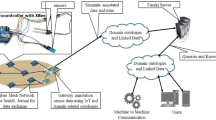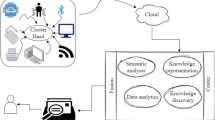Abstract
In the Internet of Things (IoT), data-producing entities sense their environment and transmit these observations to a data processing platform for further analysis. Applications can have a notion of context awareness by combining this sensed data, or by processing the combined data. The processes of combining data can consist both of merging the dynamic sensed data, as well as fusing the sensed data with background and historical data. Semantics can aid in this task, as they have proven their use in data integration, knowledge exchange and reasoning. Semantic services performing reasoning on the integrated sensed data, combined with background knowledge, such as profile data, allow extracting useful information and support intelligent decision making. However, advanced reasoning on the combination of this sensed data and background knowledge is still hard to achieve. Furthermore, the collaboration between semantic services allows to reach complex decisions. The dynamic composition of such collaborative workflows that can adapt to the current context, has not received much attention yet. In this paper, we present MASSIF, a data-driven platform for the semantic annotation of and reasoning on IoT data. It allows the integration of multiple modular reasoning services that can collaborate in a flexible manner to facilitate complex decision-making processes. Data-driven workflows are enabled by letting services specify the data they would like to consume. After thorough processing, these services can decide to share their decisions with other consumers. By defining the data these services would like to consume, they can operate on a subset of data, improving reasoning efficiency. Furthermore, each of these services can integrate the consumed data with background knowledge in its own context model, for rapid intelligent decision making. To show the strengths of the platform, two use cases are detailed and thoroughly evaluated.















Similar content being viewed by others
Notes
References
Abowd GD, Dey AK, Brown PJ, Davies N, Smith M, Steggles P (1999) Towards a better understanding of context and context-awareness. In: Handheld and ubiquitous computing. Springer, Berlin, pp 304–307
Al-Fuqaha A, Guizani M, Mohammadi M, Aledhari M, Ayyash M (2015) Internet of things: a survey on enabling technologies, protocols, and applications. IEEE Commun Surv Tutor 17(4):2347–2376
Al-Jadir L, Parent C, Spaccapietra S (2010) Reasoning with large ontologies stored in relational databases: the OntoMinD approach. Data Knowl Eng 69:1158–1180
Ali MI, Ono N, Kaysar M, Griffin K, Mileo A (2015) A Semantic processing framework for IoT-enabled communication systems. In: The Semantic Web-ISWC 2015. Springer, Berlin, pp 241–258
Alshareef H, Grigoras D (2015) First responder help facilitated by the mobile cloud. In: Cloud technologies and applications (CloudTech), 2015 International conference on IEEE, pp 1–8
Atzori L, Iera A, Morabito G (2010) The internet of things: a survey. Comput Netw 54:2787–2805
Baralis E, Cagliero L, Cerquitelli T, Garza P, Marchetti M (2011) CAS-Mine: providing personalized services in context-aware applications by means of generalized rules. KAIS 28(2):283–310
Barnaghi P, Wang W, Henson C, Taylor K (2012) Semantics for the internet of things: early progress and back to the future. Int J Semant Web Inf Syst 8:1–21
Bechhofer S, van Harmelen F, Hendler J, Horrocks I, McGuinness DL, Patel-Schneider PF, Stein LA (2004) OWL web ontology language reference. Tech. rep., W3C. http://www.w3.org/TR/owl-ref/
Bergamaschi S, Castano S, Vincini M, Beneventano D (2001) Semantic integration of heterogeneous information sources using a knowledge-based system. Data Knowl Eng 36:215–249
Bonte P, Ongenae F, Schaballie J, De Meester B, Arndt D, Dereuddre W, Bhatti J, Verstichel S, Verborgh R, Van de Walle R et al. (2015) Evaluation and optimized usage of OWL 2 reasoners in an event-based eHealth context. In: OWL Reasoner Evaluation Workshop, vol 4. CEUR
Byun HE, Cheverst K (2004) Utilizing context history to provide dynamic adaptations. Appl Artif Intell 18:533–548
Calbimonte JP, Sarni S, Eberle J, Aberer K (2014) XGSN: an open-source semantic sensing. Middleware for the web of things. Terra Cognita and Semantic Sensor Networks, p 51
Card SK, Robertson GG, Mackinlay JD (1991) The Information visualizer, an information workspace. In: Proceedings of the SIGCHI conference on human factors in computing systems. ACM, pp 181–186
Compton M, Barnaghi P, Bermudez L, GarcíA-Castro R, Corcho O, Cox S, Graybeal J, Hauswirth M, Henson C, Herzog A et al (2012) The SSN ontology of the W3C semantic sensor network incubator group. Web Semant 17:25–32
Crockford D (2006) The application/JSON Media type for javascript object notation (JSON). Internet informational RFC 4627
De S, Elsaleh T, Barnaghi P, Meissner S (2012) An internet of things platform for real-world and digital objects. Scalable Comput Pract Exp 13(1):45–58
De Backere F, Ongenae F, Vannieuwenborg F, Ooteghem JV, Duysburgh P, Jansen A, Hoebeke J, Wuyts K, Rossey J, Van den Abeele F et al (2014) The OCareCloudS project: Toward organizing care through trusted cloud services. Inform Health Soc Care 0:1–19
Dey AK, Abowd GD, Salber D (2001) A conceptual framework and a toolkit for supporting the rapid prototyping of context-aware applications. Comput Hum Interact 16:97–166
Ensan F, Du W (2011) A knowledge encapsulation approach to ontology modularization. KAIS 26(2):249–283
Famaey J, Latré S, Strassner J, De Turck F (2010) An ontology-driven semantic bus for autonomic communication elements. In Lecture Notes in Computure Science, vol 6473. Springer, Berlin, pp 37–50
Forkan A, Khalil I, Tari Z (2014) CoCaMAAL: a cloud-oriented context-aware middleware in ambient assisted living. Future Gener Comput Syst 35:114–127
Gray AJ, García-Castro R, Kyzirakos K, Karpathiotakis M, Calbimonte JP, Page K, Sadler J, Frazer A, Galpin I, Fernandes AA, et al. (2011) A semantically enabled service architecture for mashups over streaming and stored data. In: The Semanic Web: research and applications. Springer, Berlin, pp 300–314
Gruber TR (1993) A translation approach to portable ontology specifications. Knowl Acquis 5:199–220
Haarslev V, Hidde K, Möller R, Wessel M (2012) The racerpro knowledge representation and reasoning system. Semant Web 3:267–277
Hogan A, Harth A, Polleres A (2008) Saor: authoritative reasoning for the web. In: The Semantic Web. Springer, Berlin, pp 76–90
Horridge M, Bechhofer S (2011) The OWL API: a Java API for owl ontologies. Semant Web 2:11–21
Horrocks I, Patel-Schneider PF, Boley H, Tabet S, Grosof B, Dean M (2004) SWRL: A Semantic Web Rule Language Combining OWL and RuleML. Tech. rep World Wide Web Consortium
Huertas Celdran A, Clemente G, Felix J, Gil Perez M, Martinez Perez G (2013) SeCoMan: A semantic-aware policy framework for developing privacy-preserving and context-aware smart applications
Hustadt U, Motik B, Sattler U (2005) Data complexity of reasoning in very expressive description logics. IJCAI international joint conference on artificial intelligence, pp 466–471
(2016) Indra: IoT interoperability platform with a big data approach. www.sofia2.com
Kang J, Park S (2013) Context-aware services framework based on semantic web services for automatic discovery and integration of context. Int J Adv Comput Technol 5(4):439–448
Kostelnik P, Sarnovsk M, Furdik K (2011) The semantic middleware for networked embedded systems applied in the Internet of Things and Services domain. Scalable Comput Pract Exp 12(3):307–316
Li X, Eckert M, Martinez JF, Rubio G (2015) Context aware middleware architectures: survey and challenges. Sensors 15(8):20570–20607
McGuinness DL, Van Harmelen F et al (2004) OWL web ontology language overview. W3C Recommendation 10
Mineraud J, Mazhelis O, Su X, Tarkoma S (2015) A gap analysis of Internet-of-Things platforms, pp. 1–7
Motik B, Grau BC, Horrocks I, Wu Z, Fokoue A, Lutz C (2009) OWL 2 web ontology language profiles. W3C Recommendation 27:61
Nelis J, Verschueren T, Verslype D, Develder C (2012) DYAMAND: dynamic, adaptive management of networks and devices. In: Local Computer Networks (LCN), 2012 IEEE 37th conference on IEEE, pp 192–195
Ongenae F, Bleumers L, Sulmon N, Verstraete M, van Gils M, Jacobs A, Zutter SD, Verhoeve P, Ackaert A, Turck FD (2011) Participatory design of a continuous care ontology—towards a user-driven ontology engineering methodology. In: KEOD. SciTePress, pp 81–90
OSGi Alliance (2009) OSGi Service Platform Release 4. http://www.osgi.org/. Accessed 9 Sept 2015
Palmisano I (2014) JFact DL Reasoner. http://jfact.sourceforge.net/. Accessed 1 July 2015
Palmisano I (2014) Reasoners, OWL API Support, papers about the OWL API. https://github.com/owlcs/owlapi/wiki/Reasoners,-OWL-API-Support,-papers-about-the-OWL-API. Accessed 23 April 2015
Patkos T, Chrysakis I, Bikakis A, Plexousakis D, Antoniou G (2010) A reasoning framework for ambient intelligence. In: Artificial intelligence: theories, models and application. Springer, Berlin, pp 213–222
Perera C, Zaslavsky A, Christen P, Georgakopoulos D (2014) Context aware computing for the internet of things: a survey. IEEE Commun Surv Tut 16:414–454
Pinto HS, Martins JP (2004) Ontologies: how can they be built? KAIS 6(4):441–464
PrudHommeaux E, Seaborne A et al (2008) SPARQL query language for RDF. W3C Recommendation 15
Shearer R, Motik B, Horrocks I (2008) HermiT: a highly-efficient owl reasoner. In: OWLED, vol 432
Simperl E (2009) Reusing ontologies on the Semantic Web: a feasibility study. Data Knowl Eng 68:905–925
Sirin E, Parsia B, Grau BC, Kalyanpur A, Katz Y (2007) Pellet: a practical OWL-DL reasoner. Web Semant 5:51–53
Soldatos J, Kefalakis N, Hauswirth M, Serrano M, Calbimonte JP, Riahi M, Aberer K, Jayaraman PP, Zaslavsky A, Žarko IP et al (2015) OpenIoT: open source internet-of-things in the cloud. In: Interoperability and open-source solutions for the internet of things. Springer, Berlin, pp 13–25
Strang T, Linnhoff-Popien C (2004) A context modeling survey. In: Workshop Proceedings
Tsarkov D, Horrocks I (2006) FaCT++ description logic reasoner: system description. In: International joint conference on automated reasoning. Springer, Berlin, pp 292–297
Tsarkov D, Palmisano I (2012) Chainsaw: a metareasoner for large ontologies. In: ORE, vol 858. CEUR Workshop Proceedings
Wang F, Hu L, Zhou J, Zhao K (2015) A survey from the perspective of evolutionary process in the internet of things. Int J Distrib Sens Netw 2015:9
Acknowledgments
OCCS was partly funded by iMinds and the IWT project nr. 110113. It involves Boone, Familiehulp Gent, Telecom-IT, Televic Healthcare and TP Vision.
R.A.M.P. was partly funded by iMinds and involves Media Innovatie Centrum, Small Town Heroes, Televic Conference and Vlaamse Media Maatschappij.
Author information
Authors and Affiliations
Corresponding author
Rights and permissions
About this article
Cite this article
Bonte, P., Ongenae, F., De Backere, F. et al. The MASSIF platform: a modular and semantic platform for the development of flexible IoT services. Knowl Inf Syst 51, 89–126 (2017). https://doi.org/10.1007/s10115-016-0969-1
Received:
Revised:
Accepted:
Published:
Issue Date:
DOI: https://doi.org/10.1007/s10115-016-0969-1




